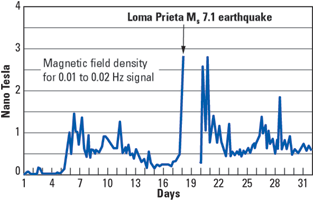What's new in exploration
Quaking predictions. Following the December 26, magnitude 9 earthquake and the subsequent tsunamis, there were many reports on the (often total) survival rate of animals. Why this is, or rather, if this is true, is impossible to say. It could have something to do with the number of animals along the seashore: I have no idea how many animals would be found there on a typical day in the affected areas, but I’ll bet there were a lot less than humans. Nothing scientific here to go on. Still, there have been so many anecdotal stories worldwide that it would be foolish to dismiss all of them. There could be something to it. 1-800-predict. Whatever that might be, it – and any other predictor that can be noticed by humans – could be verified by a toll-free telephone number. It’s been five years since I last proposed this, in this column in March 2000. Then, as now, if it’s correlative and predictive is what counts most. It is such a cheap and easy thing to do, it must have been proposed before. I’m guessing that the objection would be the unknown nature of the underlying science: fear of chasing ghosts and goofballs. Fear for one’s career. But in a pragmatic sense, who cares? Be fearless. Because the system is comprised of nothing but an answering machine, it would be low cost. The system could have a menu that offers the caller choices, such as “Press 1 if your water, oil or gas well is behaving oddly.” Actually, this one is fairly well established, but the utility of it is not. Perhaps this is because there has not been a reliable data-capture system in place. However, there have been instances in China when well-behavior has been predictive of an earthquake and helped save lives. “Press 2 if your cat is riding the ceiling fan. Press 3 if aliens from space told you there will be an earthquake.” It doesn’t really matter, as long as it works as a predictor. Even if the number of crank phone calls soars right before an earthquake, as long as it’s predictive, we’ll take the results now and work on finding out “why” later. Besides animal behavior and well-production anomalies, there may be other indicators, such as ELF. ELF. Extremely Low Frequency variations in the electromagnetic field have been known for many years, but making sense of them is another matter. For quakes, the idea began when, by pure chance, researcher Tony Fraser-Smith at Stanford University just happened to be recording ELF measurements when the 1989 San Francisco earthquake hit (see figure). His magnetometer recorded a 20-times increase in ELF, two weeks before the quake. That level held right up to the quake. Maybe it was coincidence, or bad data, but it got some folks thinking.
Satellites in 1981 and 1989, belonging to France and Russia, had detected ELF associated with earthquakes, although not as predictors. Like animal behavior, there isn’t a scientific theory to support it; we’re still at the hypothesis and testing stage. Perhaps there’s a connection, where it’s the ELF that the animals are sensing. A constellation of 55 ground-based ELF sensors in California may bring results in very earthquake-prone areas, but the odds do not favor it. What was needed was a purpose-built satellite that could detect ELF from the 70 or so strong, magnitude 6 and above quakes that occur each year. Enter the company, Quakefinder. This company has an audacious business plan: to predict earthquakes and then sell that information for profit. The company launched its 10-lb micro-satellite, QuakeSat-1, in summer 2003. In summer 2004, the French space agency CNES launched the DEMETER (Detection of Electro-Magnetic Emissions Transmitted from Earthquake Regions), another micro-satellite, which “looks” at Europe, the eastern one-third of Asia, and the northern half of Africa. As the name implies, it is designed to detect changes in the ionosphere due to geophysical phenomena such as earthquakes, volcanoes and tsunamis. A December 2004 agreement has allowed Quakefinder to now receive data from DEMETER. The company says that it has some positive results, having picked up more than 2,000 groupings of ELF data over earthquake-prone areas. It claims to have measured elevated ELF with its satellite “months before” a magnitude 6.5 quake in San Simeon, California, in December 2003. But the company only uses ELF for half of its work. The other half is infrared radiation, which can also be detected from space. The hypothesis is that, as stress increases, crystalline basement rock might emit ions into the atmosphere, which could produce field effects. Heat might also build up, signaling an impending earthquake. It is rather easy to visualize this happening. Whether it actually does is another matter. For me, the most probable case is that some earthquakes are predictable, but only quakes of certain classes and strengths. Matching the type and intensity of earthquakes with their predictors, if any, is a daunting task, especially if it is to be reliable. One unfortunate aspect of all this: the company is not sharing its data with any scientific bodies for analysis and critique. While it is a for-profit company, it needs this type of peer review to get more funding, something maverick companies such as this always need. Still, secret or not, I have to admire their gumption. These folks deserve the attention of an open mind. Pried open if need be.
|
|||||||||||
- Prices and governmental policies combine to stymie Canadian upstream growth (February 2024)
- U.S. producing gas wells increase despite low prices (February 2024)
- U.S. drilling: More of the same expected (February 2024)
- U.S. oil and natural gas production hits record highs (February 2024)
- Quantum computing and subsurface prediction (January 2024)
- U.S. upstream muddles along, with an eye toward 2024 (September 2023)





